"Flash of Fury" How the US crushed socialism in Grenada
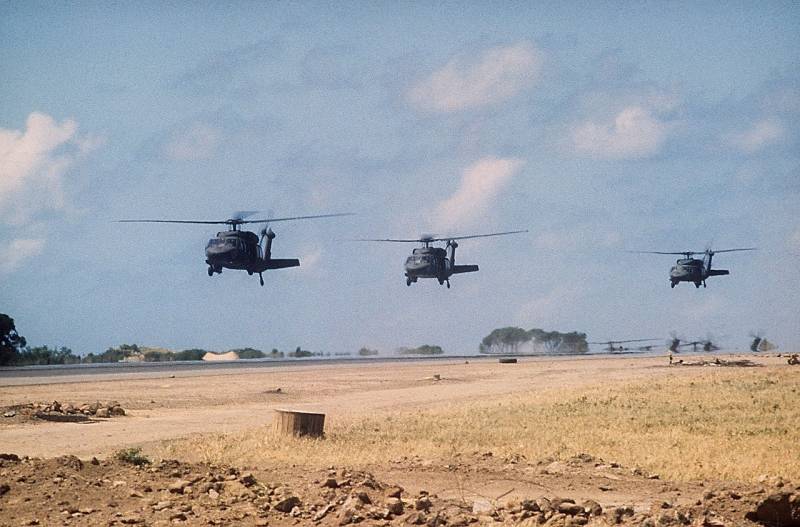
Walnut Republic
Grenada, an island nation in the southeastern Caribbean, was a British colony and only became independent in 1974. At the same time, Grenada was part of the Commonwealth of Nations, which formally remained under the British crown. The basis of the economy is the export of nutmeg.
In the 1970s, politics was dominated by the Grenada United Labor Party, led by Eric Gairy. Her program was based on a synthesis of left-wing populism with radical nationalism. Because of the imprint of the party leader's personality, it was called "Geyrism". The party was supported by rural workers and the urban lower classes. In 1967, Gairy became head of government of the associated state of Grenada (under British sovereignty). Since 1974, Gairy headed the government of the already independent Grenada.
The Gairy regime quickly degenerated into an authoritarian dictatorship of a tyrant who considered himself a messiah and raised the issue of studying UFOs at the UN. The opposition was harshly suppressed. Including with the help of the “Gang of Mongooses” - a paramilitary group of a criminal nature, Gairy’s personal guard. Members were recruited from criminal and lumpen circles. This did not prevent the “mongooses” from actively collaborating with the police, who also participated in the suppression of the opposition. Death squads terrorized the dissatisfied.
In foreign policy, Geyrism was oriented towards the West and showed pronounced anti-communism. The Gairy regime was actively supported by the United States and the leader of the junta in Chile, Pinochet (Ultracapitalism of Pinochetism).
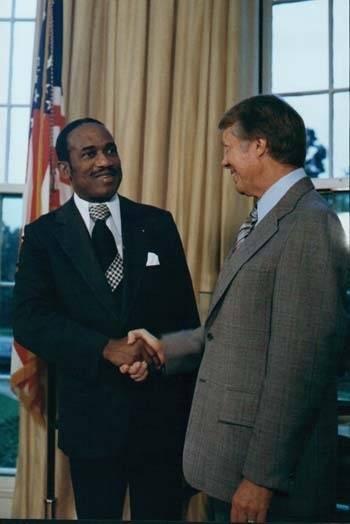
Jimmy Carter, US President, and Eric Gairy, Prime Minister of Grenada
"Gairy, get out on the UFO"
Gairy's bloody regime provoked widespread resistance. He was hated by both conservative and left-wing activists. Also, geyrism could not solve socio-economic issues; the life of the masses only worsened.
In the wake of general discontent, the left-wing New Movement for Welfare, Education and Liberation (New Joint Movement for Welfare, Education and Liberation) overthrew the dictator in March 1979.
There was practically no resistance. The bandit regime easily imprisoned and killed the defenseless. But the bandits did not dare to enter into a real fight. "Mongoose" was dispersed. Their leaders Moslin and Willie Bishop (28 and 19 convictions) were arrested. Gairy himself was at that moment in New York, where he was going to speak at a UN meeting, and remained in the United States.
The People's Revolutionary Government, led by Maurice Bishop and his deputy Bernard Cord, was declared in power in Grenada. They formed the People's Revolutionary Army and the party militia (People's Revolutionary Militia, based on the former police), and created the People's Revolutionary Police. St. George's (the capital of Grenada) set a course for cooperation with socialist countries, primarily with Cuba and the USSR. With their help they armed the army. Moscow helped with essential goods.
Havana sent its teachers, doctors and builders to the Walnut Republic. Cuban workers began construction of Point Salinas International Airport, which would replace the aging Pearls Airport on the north side of the island and promote tourism. The airport project itself was prepared by the Canadians, and the construction contract was awarded to a British company.
Grenadian socialists carried out a number of positive reforms. Jobs were created in cities and rural areas - agro-industrial complexes, state farms, where the unemployed were sent. With the help of Cuba, a fishing fleet is being formed. The tourism sector is intensifying. We fought against illiteracy. From 1979 to 1983, the proportion of illiterate people fell from 35% to 5%. Unemployment fell from 49% to 14%. Modern healthcare developed. Economic policy was close to the Soviet NEP.
American writer Bill Biggelow noted:
On the other hand, one dictatorship was replaced by another. Political opposition was banned, and repression quickly began. The leadership, as problems grew, split into “petty bourgeois philistines” led by Bishop and hard “Marxists” - like Deputy Prime Minister Bernard Cord, army commander Hudson Austin.
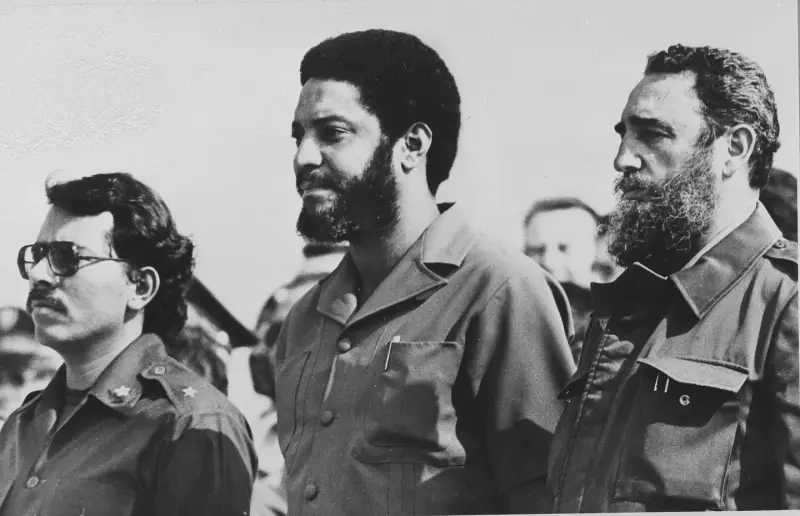
Nicaraguan President Daniel Ortega, Grenada Prime Minister Maurice Bishop and Cuban leader Fidel Castro in Havana
Conflict with the US
On June 19, 1980, an attempt was made on Bishop's life. Following the commemoration of Grenada's national hero Alistair Strawn, who died during a conflict with police in 1974, the first stories Grenada military parade.
At 14 p.m. 50 minutes local time, an explosion occurred near the central stand, where Maurice Bishop, Governor General Paul Schoon and Cuban Ambassador Julian Torres Rizo were sitting. The concrete platform saved the country's leaders from death, but about 90 people were injured, including 13-year-old Lauryn Philip and 23-year-old Loris Humphrey.
Bishop visited the wounded in the hospital, and then made a radio speech in which he accused the US CIA of organizing the bombing and carrying out the Pyramid plan aimed at overthrowing the Grenadian regime.
Bishop said:
Imperialism is scared of our revolution, it is afraid of losing its profits, since the dollar is its only God. He is afraid of the historical example of the Grenadian Revolution, which shows what a small, poor country with a small population and limited resources can do when its people take their destiny into their own hands.”
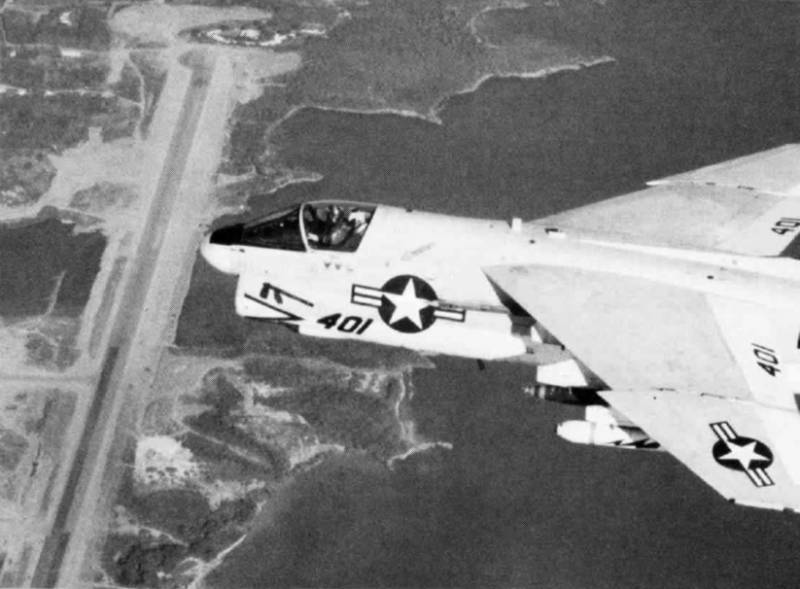
It is clear that Washington did not like all this. The United States feared that it would have a new Cuba close at hand. Another socialist regime in the Caribbean meant a serious defeat for the United States in a region that it considered its sphere of influence. The United States also needed to restore its superpower status after its defeat in Vietnam.
The construction of the airport was heralded by US President Ronald Reagan as evidence that the Grenada government intended to allow it to be used as a base for Soviet and Cuban air forces.
An economic war was launched against Grenada.
America refused loans to Grenada and did not help during natural disasters. Washington insisted that the countries of the Caribbean and the European Economic Community and international financial institutions avoid cooperation with the revolutionary government and not lend to it.
In April 1982, Reagan, at a meeting with the leaders of the Eastern Caribbean states, openly accused the Grenada government of spreading the “Marxist virus” in other countries. In March 1983, Reagan declared a boycott of Grenada and urged American tourists not to visit the island. At the same time, the American fleet conducted exercises near Grenadian territorial waters. In response, Grenada mobilized the army (about 1,5 thousand soldiers) and police.
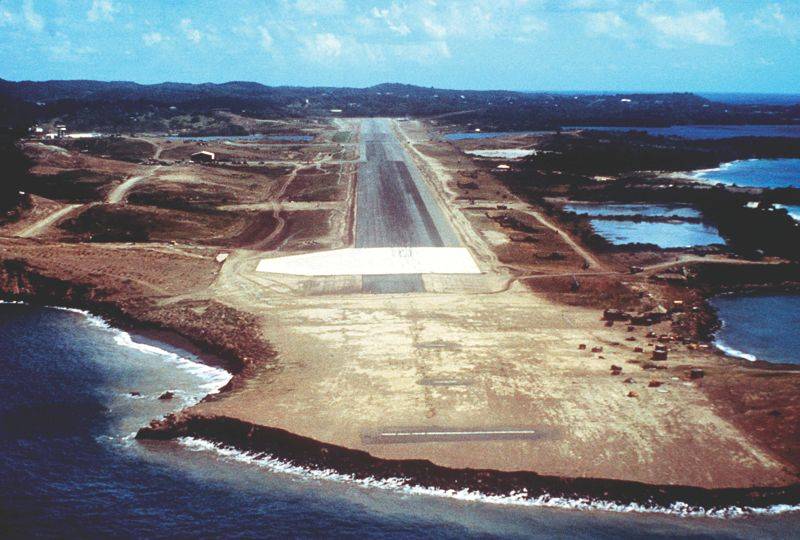
Point Salinas International Airport under construction (1983)
Crisis and new revolution
By 1983, economic sanctions and mistakes by the Grenadian leadership themselves led to another internal crisis. Bishop is seeking reconciliation with the United States, and negotiations are underway with the IMF to obtain an emergency loan.
Naturally, this did not suit the radical left. On October 12, 1983, the Central Committee of the party, where the Marxists had a majority, removed Bishop from the leadership and put him under house arrest. The Prime Minister was urged to submit to the general line of the Central Committee. Mass demonstrations in support of Bishop began in the capital. On October 19, a crowd of thousands of supporters of the prime minister freed him. However, the military counterattacked. Bishop and his most active supporters were captured and executed (11 people).
On the evening of October 19, General Hudson Austin spoke on Grenadian radio. In his speech, Austin accused Bishop of “connections with counter-revolutionaries” and the intention to “destroy the leadership of the party,” announced his execution, announced the dissolution of the People’s Revolutionary Government and the creation of the Revolutionary Military Council. Cord became the new prime minister. Arrests of Bishop's supporters began. The Politburo and Central Committee of the New Jewel Movement and the army command expressed support for the coup.
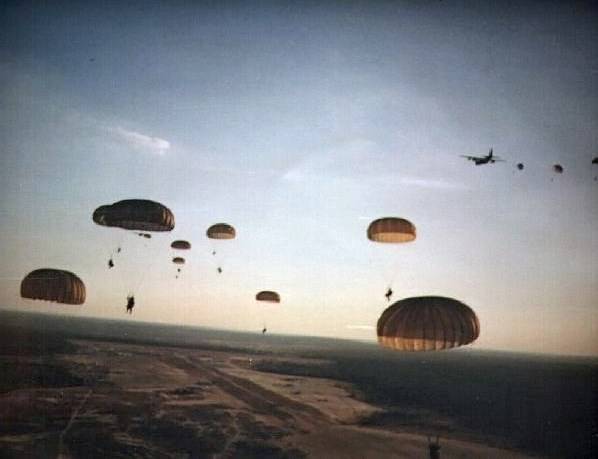
Landing of paratroopers of the 75th Ranger Regiment near Point Salinas Airport
"Ghost of Vietnam"
This coup became the reason for US military intervention.
Washington inflated the “Red Menace.” On October 21, an extraordinary session of the Organization of Eastern Caribbean States (OECS) was convened to discuss ways to end the anarchy and violence in Grenada. Acting in accordance with Article 8 of the 1981 OECS Collective Security Treaty, the session participants approached Barbados, Jamaica and the United States with a proposal to join the multinational peacekeeping force in Grenada.
The American administration also expressed fears for the fate of 630 American students who were at St. George's University at that time, as well as on student campuses in the area of Pearls Airport. In fact, no one threatened the students. They were simply guarded in case of unrest. The Grenadian government was ready to expel them at any moment.
Washington needed a “small victorious war” to wash away the shame of Vietnam and show Latin America who’s boss. During this period, the Sandinista National Liberation Front came to power in Nicaragua, which declared to “put an end to American interference in the internal affairs” of the country. Left-wing guerrillas have become more active in El Salvador.
Reagan noted in his memoirs:
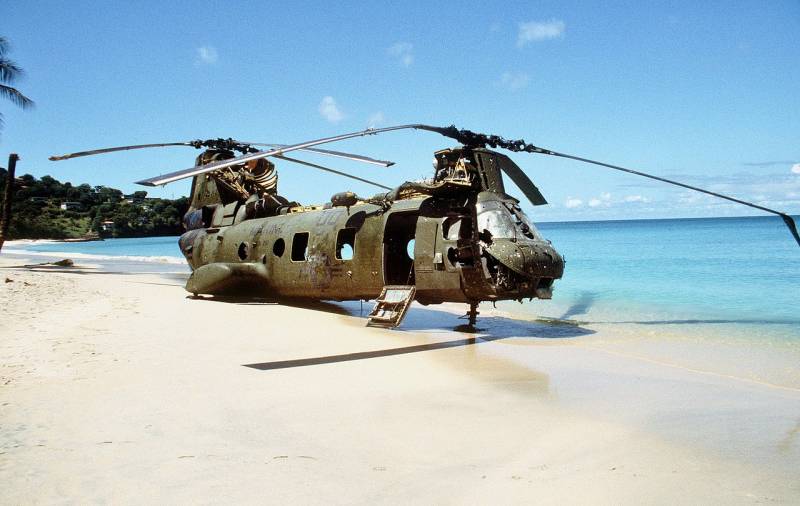
Downed CH-46 Sea Knight military transport helicopter on the beach in Grand Anne
The forces of the parties
The armed forces of Grenada numbered about 1–200 soldiers, together with the police up to 1, armed with a dozen armored personnel carriers, several 500-mm anti-aircraft guns, anti-aircraft machine guns, a couple of dozen mortars and grenade launchers. Plus a variety of small arms - Soviet, Czechoslovak, American and British. Overall this weapons it was not enough even for normal defense, not to mention the “red expansion”. The Grenadians were supported by several hundred Cuban military builders who had only small arms.
The Americans had an overwhelming advantage in the air, at sea and in the number of bayonets. More than 7 thousand American soldiers from the Marine Corps, 82nd Airborne Division, 75th Airborne Reconnaissance Regiment (Ranger Regiment), 1st Special Forces Operational Regiment (Delta). Plus sapper-engineering and logistics units. Contingent of Eastern Caribbean states (350 people). Air Force support - over 70 aircraft, fleet - aircraft carrier "Independence", 1 cruiser, 3 destroyers, 1 frigate, several landing ships (including a helicopter carrier), etc.
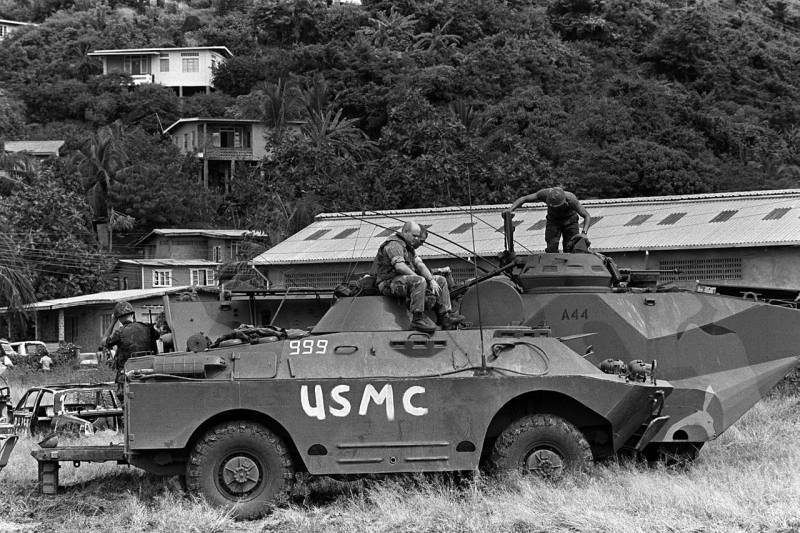
US Marines sit aboard a captured Soviet-made BRDM-2 amphibious armored reconnaissance vehicle (foreground) and an AAV-7A1 tracked landing vehicle
The plan for Operation Flash of Fury called for a surprise landing of both amphibious and airborne forces to capture Grenada's most important military and administrative installations. The bulk of the invasion force consisted of units of Rangers and Marines, with the 82nd Airborne Division in second echelon. Overall command was exercised by the commander of the 2nd Fleet (North Atlantic area of responsibility), Vice Admiral Joseph Metcalf. His first deputy was Major General Norman Schwarzkopf, who led the landing forces.
Grenada was divided into two zones - northern and southern. The border between them ran along the road connecting St. George's and Grenville. The northern group consisted of an amphibious landing force, which was planned to land in the northeast of the island, in the area of the Pearl airfield. The southern group was represented by an airborne assault force, the landing site of which was chosen at the Point Salinas airport under construction on the southwestern tip of the island. This was due to the fact that there were few places on the island available for landing.
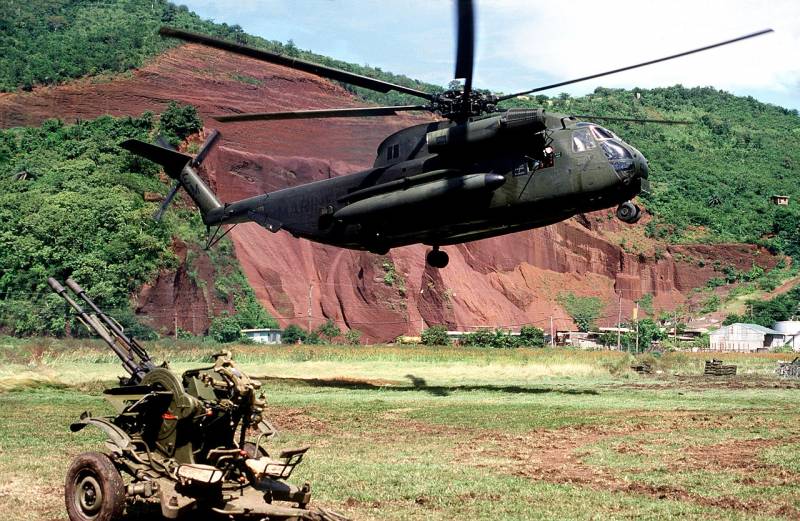
A US Marine Corps CH-53D transport helicopter over a Soviet-made ZU-23 position captured from the Grenada Armed Forces
Invasion
It is worth noting that the operation was prepared in a hurry, there were many overlaps, and the reconnaissance was carried out poorly. The commanders did not have topographic maps; they used tourist maps. The number of the enemy, including the Cubans, was underestimated. Therefore, if, for example, there were Soviet troops or Cuban regulars with heavy weapons on the island, the Americans would simply be shot in the area of two airports. There would be many casualties. The American Armed Forces were just lucky.
Immediately before the landing, the Americans conducted aerial reconnaissance. On the night of October 23-24, several reconnaissance and sabotage groups totaling up to 50 people were delivered to the island by helicopter.
On the morning of October 25, 1983, the invasion began. The Americans immediately managed to suppress communications in Grenada. It was a success. From the moment of the invasion, an American radio station began broadcasting, calling on the population of Grenada to “remain calm” and the soldiers to “do not resist.”
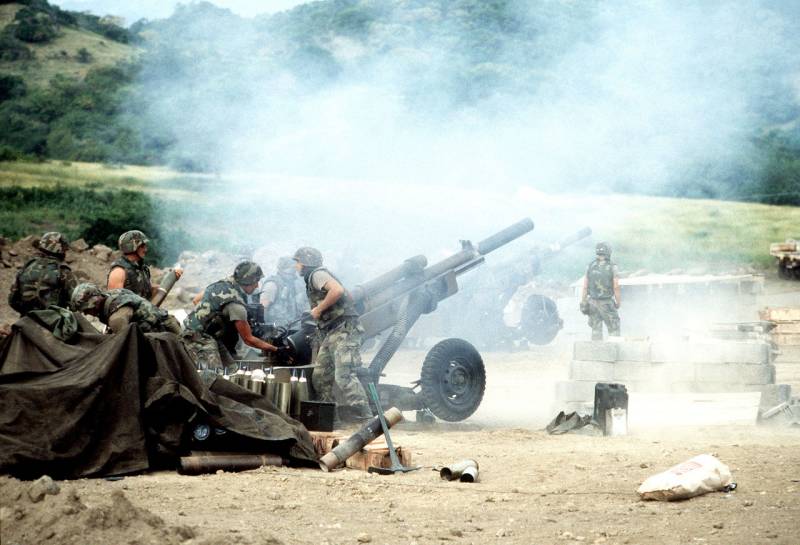
Position of 105 mm M102 howitzers of the 1st Battalion, 319th Artillery Regiment, 82nd Airborne Division
It was not possible to take the Pointe Salinas airfield on the move. The Cubans who were in the area of the airport resisted, as did the Grenadian anti-aircraft gunners. Several helicopters were shot down. As a result, the Americans were able to land troops. Then the Rangers, with support aviation repelled a counterattack by the Grenadian army, knocking out 3 BTR-60s. There was resistance in other places as well.
The Americans mistakenly bombed the hospital, killing, according to various sources, from 12 to 47 people. A shell hit a kindergarten, killing 17 children. The Soviet embassy was also shelled and one employee was seriously wounded.
Due to various inconsistencies, the operation, designed to take several hours, lasted four days. On the evening of the 26th, serious reinforcements were landed on the island. On October 27, the resistance of the Grenadian army was generally suppressed. The Grenadian government led by Kord was arrested. On October 28, the US military released the last students. The Grenadian army was disarmed and disbanded.
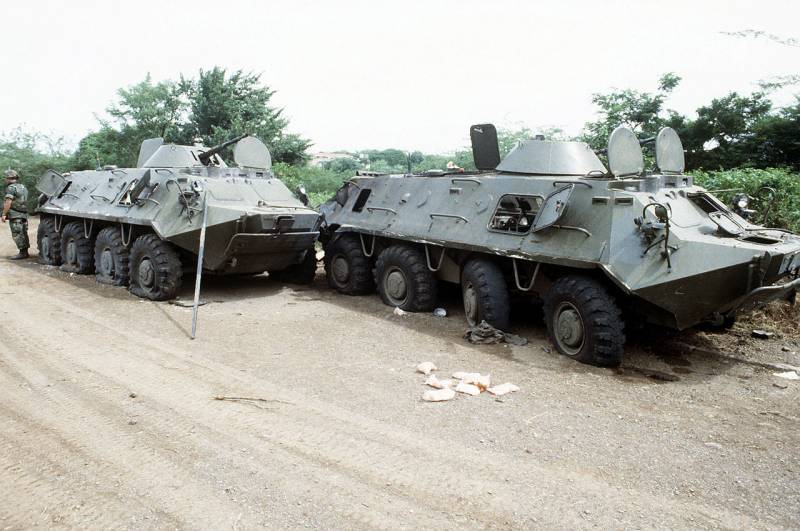
BTR-60PB AF Grenada
Results
According to official American data, announced on December 17, 1983, 45 Grenadians were killed and 337 wounded during the operation. The Cubans lost 24 people killed and 49 wounded, more than 600 were captured (they were later deported to their homeland).
The US lost 19 people killed and 116 wounded. Nine helicopters were shot down and several were damaged.
The invasion was condemned by socialist countries led by the USSR and China, as well as many countries in Europe and Latin America. The invasion was demanded to be canceled by British Prime Minister M. Thatcher, who was not informed about the operation. On October 28, 1983, the United States used its veto power to prevent the adoption of a draft UN Security Council resolution regarding the events in Grenada (which was voted for by 11 of the 12 members of the UN Security Council - all except the United States).
On November 2, 1983, the UN General Assembly adopted resolution No. 38/7, which assessed the invasion of Grenada as a gross violation of international law and an encroachment on the independence, sovereignty and territorial integrity of this state and demanded an immediate end to the armed intervention in this country and the withdrawal of foreign troops from there . 108 countries voted in support of the resolution, while the United States and 8 other countries voted against it.
On October 29, Washington lifted all economic sanctions imposed against Grenada and provided the island with $110 million in compensation for damage caused by the actions of the American army. American troops were withdrawn from the island by December 15, 1983. A small contingent remains, including military personnel from the Eastern Caribbean states.
On December 3, 1984, elections were held in the country, in which the New National Party won, uniting conservative and centrist forces; it received more than 58% of the vote. Eric Gairy's United Labor Party came second. The new Prime Minister Herbert Blaise, a staunch anti-communist and Reaganist, pursued a policy of increased rapprochement with the United States.
The new government immediately took the path of reducing social spending. The literacy program was curtailed, agricultural cooperatives were dissolved, and land was privatized. Unemployment again went through the roof - 60%. Medicine again became the same - for the wealthy segments of the population. The “mongoose” bandits were released, but until the 2000s they lost their political role, becoming ordinary street crime.
Participants in the events related to the death of M. Bishop were arrested and brought to trial in Grenada. Ordinary Grenadians for the most part positively perceived the punishment for the murderers of the very popular Bishop. In December 1986, the defendants were sentenced to death, which was later commuted to life imprisonment (and after some time the cases were reviewed and the prisoners were released).
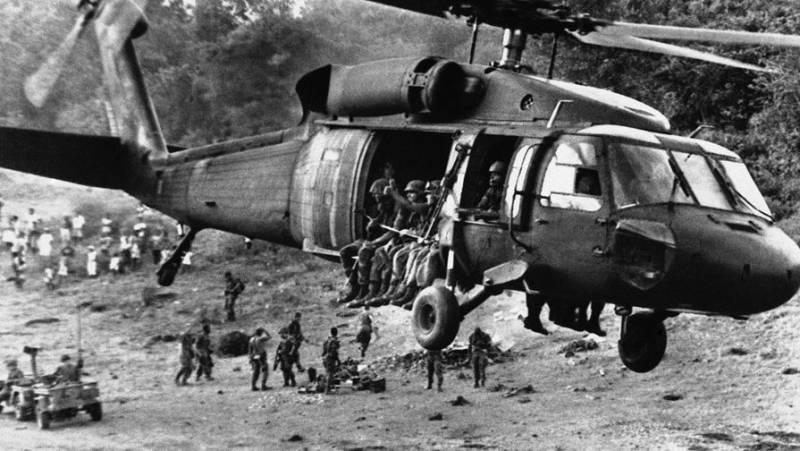
US Army soldiers in Grenada, December 1983
Information